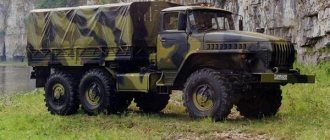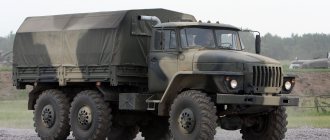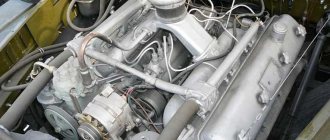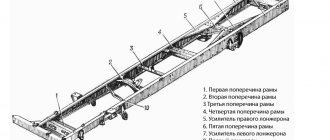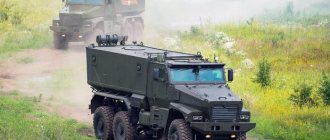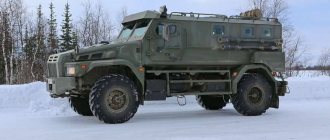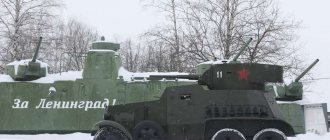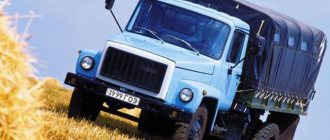Armored trucks "Federal-M" and "Ural-VV"
Interesting details about the progress of the program for creating armored trucks for the Russian army and the Ministry of Internal Affairs of the Russian Federation are given in the article by Fyodor Lapshin “Armored Vehicles”, published in issue No. 24 of the AutoReview magazine.
The article, in particular, reports that the Russian Ministry of Internal Affairs ordered 50 bullet-proof Ural-Federal trucks at a price of 5.34 million rubles. for each and five more explosion-proof ones for 7.87 million rubles. Moreover, apparently some of them were noticed by the author of the article on the way to Voronezh. In total, hundreds of “armored Urals” have been delivered to the Caucasus since the beginning of the 2000s, and fighters call them “Pokemon”.
In addition, the material evaluates the second Federal-M armored truck on the Ural-55571 chassis, created by the Institute of Special Equipment. The first sample on the Ural-4320 chassis was sent for testing to the internal troops of the Ministry of Internal Affairs. A special feature of the new truck is its single-volume capsule body. The short armored hood provides excellent visibility. Comfortable original steps are noted. The width of the doors is 8 cm at the end, the thickness of the armor plate is 6 mm. Protection against explosion - either from 3 kg of TNT (for this specimen), or from 7 kg (for specimen No. 1). The ergonomics of the driver's seat are harsh: the steering wheel is not adjustable, the gas pedal is almost vertical. Everything inside is lined with anti-fragmentation protection, which is attached with Velcro.
Under the feet of the front riders there are special “anti-overload” platforms that will reduce the effect of the shock wave on the legs. The driver's seat, like all the others, is also “anti-overload”; the seats in the cabin also have footrests.
The author of the article was confused by the fact that the soldiers were sitting with the backs of their heads facing the armored glass, and he suggested placing the windows and seats in a checkerboard pattern.
The engine that powers this example is YaMZ-236, environmental standard Euro 0. Moreover, this particular example was built by order of one of the countries of North Africa. At the same time, the workshop was preparing vehicle No. 3, for the Internal Troops of the Ministry of Internal Affairs.
| Interior of the Federal-M truck |
| Source: Institute of Special Equipment |
The development of the Ural auto is also analyzed. Chassis - Ural 4320, equipped with a new in-line engine YaMZ-536. The cabin interior is more elegant, since the front panel is unified with the army Typhoon. The armor is not uniform, but differentiated (“the forehead” and windows are protected more strongly, according to the sixth class of GOST, the engine compartment - according to the third). Protection against explosion is weaker than that of the Federal-M (two kilograms of explosives are declared).
| Armored truck "Ural-VV" |
| Source: Evgeny Chesnokov / via anothercity.livejournal.com |
The design has an unusual solution: a spare wheel with a winch on the side (on the Federal-M the spare wheel will be mounted at the rear) and a rear ladder that folds down using a powerful pneumatic cylinder (it can also be folded out manually). Under the engine and gearbox there is steel protection, which the Federal-M does not have: according to the Ural designers, it protects against fragments, which was tested in the experience of the war in Chechnya.
The Ural-VV hood is decorative, made of fiberglass, the engine is enclosed in a “sarcophagus” of bolted armor panels. The frontal armored glass is solid, which means that, according to estimates, its weight can reach 350 kg - therefore, replacement will only be possible in the factory. The door to the salon opens in the opposite direction - which means it can serve as a potential “bullet catcher”. The seats in the cabin are not “anti-overload”; at least they do not have footrests. Access to the loopholes is more convenient than that of the Federal-M, but there are only 9 loopholes in the cabin for 13 fighters.
Next year, the Ural Automobile Plant plans to produce 10 such vehicles for the Ministry of Internal Affairs.
The prices are also interesting. “Federal-M” costs from 8 to 8.6 million rubles, “Ural-VV” – 10 million rubles.
Armored car "Federal-42590"
Working in hot spots, soldiers of internal troops and other security forces face a number of threats. They regularly risk being ambushed or blown up by an improvised explosive device planted along their route. To counter such threats, units of the Ministry of Internal Affairs require appropriate equipment. Previously, trucks equipped with improvised armor and known collectively as “Pokemon” were used to protect personnel. Over time, they were replaced by armored cars built by industry on the basis of production vehicles using factory-produced armored modules. One of the latest models of such equipment is the Federal-42590 protected vehicle. The Federal-42590 armored vehicle is another representative of the family of vehicles of the same name, built on the basis of Ural brand trucks. As before, the project involves equipping the base chassis with a number of new units, including protective equipment and a special armored van module for transporting personnel or cargo. Over the course of several years, the Federal family of equipment has undergone a number of major changes aimed at increasing protection characteristics and improving ergonomics. As a result, various machines in the family have some differences in terms of the units used, layout, etc.
Armored car "Federal-42590" riot police of the Republic of Mordovia. Photo: Vestnik-rm.ru
Like other vehicles in the family, Federal-42590 was developed by the Institute of Special Equipment (Moscow) and is built on the basis of a Ural truck. This time the Ural-55571 chassis is taken as the basis. This all-wheel drive three-axle chassis has a load capacity of 12-14 tons, which is enough to install all the necessary equipment and maintain the required mobility characteristics. According to the developer, the curb weight of the armored car reaches 16 tons. The maximum payload weight is 5.3 tons. Thus, the chassis characteristics are used with maximum efficiency.
During conversion into an armored car, the base chassis receives a set of armor elements. Reinforced shutters are installed in front of the radiator grille, and the engine is covered with armor plates on the sides and top. The cockpit is protected in a similar way. All elements of the cabin, including doors and roof, are equipped with armor. The cabin glazing is made of armored glass. There are several loopholes for firing personal weapons. There is a hatch in the cabin roof. The level of protection is determined by the customer. It is possible to protect the driver according to class 6/6A of the GOST R 50963-96 standard.
Front doors of the armored module. Photo Insst.ru
The front platform and the side door are covered with an awning. Photo: Vestnik-rm.ru
In place of the base vehicle’s cargo area, a special armored module is mounted with space for transporting personnel or cargo. It is noteworthy that such equipment of an armored car can have a different architecture. There are known vehicles whose armored module is combined with a “classic” flatbed body. In the manufacturer's advertising materials there are images of vehicles equipped with additional armor in the form of relatively high sides.
The landing armored module of all armored cars of the Federal family is a KUNG van made of armored steel. The sides are provided with several windows and embrasures with dampers. This equipment allows soldiers to fire from personal weapons. The armored module is equipped with several doors, the number of which depends on the modification. So, in all options one or two aft doors are provided. It is also possible to install doors in the front sheet. The layout of the doors affects some of the entry and exit features.
Shields that provide additional protection for the chassis units and the bottom of the armored module. Photo: Vestnik-rm.ru
The design of the armored module uses sheets that provide class 6/6A protection. In addition, in the case of the Federal-42590 vehicle, protection of personnel from the explosion of an explosive device weighing up to 10 kg (according to other sources, up to 6 kg) is claimed. For this purpose, some design features are used, as well as special chairs for landing. To increase the survivability of the vehicle and reduce risks for the crew/troops, fuel tanks of an original design are used, which prevents fuel from spilling during an explosion, thereby reducing the likelihood of a fire.
Armored cars of the Federal family have a different design of the armored module and its internal equipment. At the same time, some common solutions are used in projects. For example, the length of the armor module is noticeably shorter than the length of the base vehicle body. Because of this, it is mounted in the center of the body or with a shift back, which is why a small area remains in front of or behind the module. The Federal-42591 armored car, in particular, has two platforms, in front and behind the module, as well as two sets of doors for the module itself. All these features make boarding and disembarking somewhat easier.
The rear part of the armored module of the Federal-42591 vehicle. The body platform and landing benches are visible. Photo by the author
This layout of the Federal-42591 allows troops to leave the vehicle through the front or rear doors. In this case, the soldiers disembarking from the front dismount through a small opening with a door in the side of the body. When exiting through the rear doors, fighters must descend through the body. For the convenience of fighters, small footrests are provided.
The Federal-42590 armored car has a slightly different layout. In its case, the armored module of increased length is installed with a shift back, and its rear part does not protrude beyond the body. This arrangement still allows disembarkation through the front doors and the opening in the side. Two doors are retained in the rear hull plate, and disembarkation is carried out using a small step at their openings and a lowered ladder. At the request of the customer, the armored module can receive only one door. In this case, a device for transporting a spare wheel is mounted on the remaining part of the stern sheet.
The aft door of the armored car "Federal-42590". Photo: Vestnik-rm.ru
Early modifications of the "Federals" had fairly simple places for landing, made in the form of ordinary benches. By using three benches (two at the sides and one in the center), the module could accommodate up to 16 people. The modern Federal-42590 vehicle, taking into account new threats, is equipped with special “mine-proof” seats that absorb part of the explosion energy. This feature significantly reduces the risks for the landing party, although it affects the capacity of the armored module. Having such seats, an armored car can transport no more than 10-12 soldiers with weapons.
The front side of the body, in which the armor module is located, is equipped with an arch for installing an awning. Armored cars with a rear platform have a second arc behind the module. If necessary, the armored module can be covered with an awning, which provides camouflage. An armored vehicle with a canopy looks almost no different from a regular truck on a similar chassis and can be confused with it when observed from a long distance.
Various options for equipping the armored module. Photos Insst.ru (above) and Vestnik-rm.ru (below)
Armored vehicles of the "Federal" family, including the "Federal-42590" model, have been mass-produced over the past few years by order of the Ministry of Internal Affairs. Such equipment is transferred to formations of internal troops, riot police units and other structures of the Ministry of Internal Affairs that need protected equipment for transporting personnel and cargo.
Having replaced the improvised “Pokémon”, which was a response to new threats, armored vehicles of the “Federal” family are actively used by various structures of the Ministry of Internal Affairs and successfully solve the assigned tasks, protecting people from mines and ambushes. Using the experience of operating old vehicles of the family, the authors of the projects create new equipment with improved characteristics, which enters service. Thanks to this, the risks for security forces are reduced, and they can safely get to the place where they need to complete their mission.
Based on materials from the sites: https://vestnik-rm.ru/ https://insst.ru/ https://bastion-opk.ru/
“Made with us” and on Yandex.Zen
Highly protected Federal-M vehicle on the Ural-4320 chassis (Ural-55571) © Army and Navy Review / otvaga2004.ru
Created by specialists from the Moscow enterprise Institute of Special Equipment, a new protected Federal-M vehicle on the chassis of a serially produced highly reliable Ural-M vehicle. 4320 and its modification Ural-55571 passed tests of the protective properties of the machine. These tests fully confirmed the stated security characteristics of the machine.
The protected Federal-M vehicle is intended for use as a vehicle for transporting personnel with the required level of protection from fire from the main types of small arms and the detonation of explosive devices in off-road conditions and on all types of roads. Currently, the security forces of Russia and a number of foreign countries Protected vehicles developed and created by the team of the Institute of Special Equipment, such as “Esaul”, “Ataman”, “Highlander”, “Tornado” and “Federal” are already widely used. Many protection technologies developed at the institute are used in the creation of modern wheeled armored personnel carriers and armored vehicles of the Tiger, Wolf, Bear and Typhoon families. The new protected Federal-M vehicle is based on the chassis of the serially produced highly reliable Ural-4320 vehicle and its modification Ural-55571. The armored body of the vehicle is made in a single-volume layout. Crew protection and vehicle survivability are ensured by vehicle armor made using volumetrically differentiated armored capsule (ODB-capsule) technology. The number of doors in an armored body, depending on customer requirements, can be from three to six. The aft door is made of double-leaf hinged doors, which ensures quick boarding and disembarking of personnel transported in the vehicle. For ease of boarding and disembarking through the aft door, a platform and a retractable ladder are equipped on the frame of the machine, and ladders are made under all other doors. The absence of a central beam in the design of the hinged aft door ensures the convenience and speed of loading and unloading of transported cargo. Reservation of the ODB capsule provides a basic level of ballistic protection according to the 5th protection class according to GOST R 50963−96. Armored glass of the vehicle body, including the windshield, provides class 6A protection. At the request of the customer, the level of ballistic protection can be increased to class 6 or 6A according to GOST. Increasing the level of ballistic protection, depending on the wishes of the customer, can be achieved by installing additional protective armor modules outside the hull or installing such modules inside the armored hull, which does not indicate an increased level of vehicle protection from the outside. Also, at the customer’s request, the Federal-M can be made with hidden armor for the engine compartment due to the fact that the specific tasks of a number of law enforcement agencies require, if possible, the absence of threatening or intimidating elements of the vehicle’s exterior in the appearance of the equipment used. The interior is equipped with anti-ricochet and anti-fragmentation protection based on aramid fabrics, developed by specialists from the Institute of Special Equipment. The front armored glass of the cabin and the armored glass of the doors are equipped with closing loopholes for firing from the standard weapons of the transported personnel. Closing loopholes are also equipped in the aft door and on the sides of the armored hull. In total, the vehicle is equipped with 17 loopholes, which ensures 360° firing from the standard weapons of transported personnel and makes it possible to repel enemy attacks from ambushes from any direction. To prevent a high concentration of powder gases in the cabin during firing, the vehicle is equipped with a gas removal system; fans operating in exhaust or injection modes are installed in the roof of the hull, and emergency ventilation and technological hatches can also be used. In addition, various weapons can be installed on these hatches at the request of the customer. In addition, at the request of the customer, one or another version of a remotely controlled combat module with a large-caliber or single machine gun, or an automatic grenade launcher of 30-40 mm caliber can be installed on the roof of the vehicle. To increase mine protection, the bottom of the ODB capsule is made in a mine-resistant design - it has a V-shaped uniforms and mine-resistant “sandwiches”. In combination with the high height of the floor from the ground - more than 1.3 meters and the presence of special mine-resistant seats, developed by specialists from the Institute of Special Equipment, which have undergone comprehensive testing and received a patent. The cabin floor has an additional raised floor for the feet, which does not come into contact with the bottom of the cabin and prevents the crew from getting injured in the legs when blown up by mines and explosive devices. The entire range of mine protection measures used in the design of the Federal-M vehicle provides a high chance for the crew and personnel inside the vehicle to continue performing a combat mission when the vehicle is detonated by mines or explosive devices with a capacity of 3 to 10 kg of TNT equivalent ( depending on the design of the ODB capsule). These characteristics were fully confirmed by tests of the Federal-M vehicle for ballistic and mine resistance. During the tests, more than 100 shots were fired at the vehicle body with TUS bullet cartridges from a 7.62 mm AKM assault rifle from ranges from 100 to 10 m. As a result of shooting at various elements of the vehicle body, such as welds, door joints, armored glass , roof, door lock niches and others, not a single penetration was obtained, qualified according to GOST requirements - the formation of a crack through which kerosene can leak. Explosion tests also confirmed the declared characteristics of the machine for explosion resistance. The detonation of the car was carried out in two stages: first detonation of 3 kg of TNT, and then detonation of 7 kg of TNT. The explosive charge was placed under the geometric center of the car interior in accordance with GOST. The test results even exceeded the designers' expectations. After the explosions, equipment readings showed the absence of exorbitant accelerations, depressurization of the housing (i.e., the absence of a flowing blast wave) and exceeding sound pressure standards. In other words, the crew and personnel in the Federal-M vehicle, when detonated by explosive devices of the same power, will not receive injuries that are dangerous to life and the performance of the combat mission. The absence of exceeding sound pressure standards allows personnel to be inside the vehicle without special headphones, which are required to be used by military personnel located inside foreign-made MRAP vehicles. Depending on the design of the hull and additional equipment, the Federal-M vehicle, together with the crew, can transport from 12 to 17 fully equipped fighters. The fuel tanks of the vehicle are equipped with special protection against splashing and ignition of fuel during an explosion, which is another “know-how” of the enterprise. Various additional equipment can be installed on the Federal-M. So, for example, the vehicle can be equipped with a blocker for radio fuses of explosive devices, a remotely controlled combat module, a system for shooting special equipment of the “Carriage” type; a complex for setting up smoke (aerosol) curtains, air conditioning systems in the cabin or additional heaters. Depending on the purpose of the vehicle, a ram bumper and a bulldozer blade can be additionally installed on it; protective grilles (armored blinds) for windows, a system for attaching external protective screens and special anti-traumatic mats. If necessary, the Federal-M can be equipped with a loud-speaking alarm system (SGU), a video surveillance and registration system, additional headlights and spotlights. The use of the Ural-4320 all-terrain vehicle chassis as the base of the Federal-M machine provides the vehicle with high operational reliability, high maintainability, unsurpassed cross-country ability and ease of crew training in operating rules. In operation, the vehicle is no different from a regular Ural, and its components and assemblies are unified with the legendary multi-purpose army vehicle. The engine compartment armor design provides quick access to the main engine systems for maintenance. Depending on the customer’s wishes, the vehicle can be equipped with either a standard diesel engine with an environmental standard of Euro 0, or with an environmental standard of Euro 2, 4 or 5. The protected Federal-M vehicle can be operated without restrictions at temperatures from -45°C up to +50°C. The design of the Federal-M armored special vehicle, which is based on the many years of experience of the Special Equipment Institute specialists in the development of multifunctional protection and life safety technologies, provides a high guarantee of the safety of personnel operating this equipment.
- otvaga2004_federal-m_03
Highly protected Federal-M vehicle on the Ural-4320 chassis (Ural-55571) © Army and Navy Review / otvaga2004.ru
- otvaga2004_federal-m_02
Protected Federal-M vehicle after testing for ballistic and mine resistance © Review of the Army and Navy / otvaga2004.ru
Working in hot spots, soldiers of internal troops and other security forces face a number of threats. They regularly risk being ambushed or blown up by an improvised explosive device planted along their route. To counter such threats, units of the Ministry of Internal Affairs require appropriate equipment. Previously, trucks equipped with improvised armor and known collectively as “Pokemon” were used to protect personnel. Over time, they were replaced by armored cars built by industry on the basis of production vehicles using factory-produced armored modules. One of the latest models of such equipment is the Federal-42590 protected vehicle. The Federal-42590 armored vehicle is another representative of the family of vehicles of the same name, built on the basis of Ural brand trucks. As before, the project involves equipping the base chassis with a number of new units, including protective equipment and a special armored van module for transporting personnel or cargo. Over the course of several years, the Federal family of equipment has undergone a number of major changes aimed at increasing protection characteristics and improving ergonomics. As a result, various machines in the family have some differences in terms of the units used, layout, etc.Armored car "Federal-42590" riot police of the Republic of Mordovia. Photo: Vestnik-rm.ru
Like other vehicles in the family, Federal-42590 was developed by the Institute of Special Equipment (Moscow) and is built on the basis of a Ural truck. This time the Ural-55571 chassis is taken as the basis. This all-wheel drive three-axle chassis has a load capacity of 12-14 tons, which is enough to install all the necessary equipment and maintain the required mobility characteristics. According to the developer, the curb weight of the armored car reaches 16 tons. The maximum payload weight is 5.3 tons. Thus, the chassis characteristics are used with maximum efficiency. During conversion into an armored car, the base chassis receives a set of armor elements. Reinforced shutters are installed in front of the radiator grille, and the engine is covered with armor plates on the sides and top. The cockpit is protected in a similar way. All elements of the cabin, including doors and roof, are equipped with armor. The cabin glazing is made of armored glass. There are several loopholes for firing personal weapons. There is a hatch in the cabin roof. The level of protection is determined by the customer. It is possible to protect the driver according to class 6/6A of the GOST R 50963-96 standard.
Front doors of the armored module. Photo Insst.ru
The front platform and the side door are covered with an awning. Photo: Vestnik-rm.ru
In place of the base vehicle’s cargo area, a special armored module is mounted with space for transporting personnel or cargo. It is noteworthy that such equipment of an armored car can have a different architecture. There are known vehicles whose armored module is combined with a “classic” flatbed body. In the manufacturer's advertising materials there are images of vehicles equipped with additional armor in the form of relatively high sides. The landing armored module of all armored cars of the Federal family is a KUNG van made of armored steel. The sides are provided with several windows and embrasures with dampers. This equipment allows soldiers to fire from personal weapons. The armored module is equipped with several doors, the number of which depends on the modification. So, in all options one or two aft doors are provided. It is also possible to install doors in the front sheet. The layout of the doors affects some of the entry and exit features.
Shields that provide additional protection for the chassis units and the bottom of the armored module. Photo: Vestnik-rm.ru
The design of the armored module uses sheets that provide class 6/6A protection. In addition, in the case of the Federal-42590 vehicle, protection of personnel from the explosion of an explosive device weighing up to 10 kg (according to other sources, up to 6 kg) is claimed. For this purpose, some design features are used, as well as special chairs for landing. To increase the survivability of the vehicle and reduce risks for the crew/troops, fuel tanks of an original design are used, which prevents fuel from spilling during an explosion, thereby reducing the likelihood of a fire. Armored cars of the Federal family have a different design of the armored module and its internal equipment. At the same time, some common solutions are used in projects. For example, the length of the armor module is noticeably shorter than the length of the base vehicle body. Because of this, it is mounted in the center of the body or with a shift back, which is why a small area remains in front of or behind the module. The Federal-42591 armored car, in particular, has two platforms, in front and behind the module, as well as two sets of doors for the module itself. All these features make boarding and disembarking somewhat easier.
The rear part of the armored module of the Federal-42591 vehicle. The body platform and landing benches are visible. Photo by the author
This layout of the Federal-42591 allows troops to leave the vehicle through the front or rear doors. In this case, the soldiers disembarking from the front dismount through a small opening with a door in the side of the body. When exiting through the rear doors, fighters must descend through the body. For the convenience of fighters, small footrests are provided. The Federal-42590 armored car has a slightly different layout. In its case, the armored module of increased length is installed with a shift back, and its rear part does not protrude beyond the body. This arrangement still allows disembarkation through the front doors and the opening in the side. Two doors are retained in the rear hull plate, and disembarkation is carried out using a small step at their openings and a lowered ladder. At the request of the customer, the armored module can receive only one door. In this case, a device for transporting a spare wheel is mounted on the remaining part of the stern sheet.
The aft door of the armored car "Federal-42590". Photo: Vestnik-rm.ru
Early modifications of the "Federals" had fairly simple places for landing, made in the form of ordinary benches. By using three benches (two at the sides and one in the center), the module could accommodate up to 16 people. The modern Federal-42590 vehicle, taking into account new threats, is equipped with special “mine-proof” seats that absorb part of the explosion energy. This feature significantly reduces the risks for the landing party, although it affects the capacity of the armored module. Having such seats, an armored car can transport no more than 10-12 soldiers with weapons. The front side of the body, in which the armor module is located, is equipped with an arch for installing an awning. Armored cars with a rear platform have a second arc behind the module. If necessary, the armored module can be covered with an awning, which provides camouflage. An armored vehicle with a canopy looks almost no different from a regular truck on a similar chassis and can be confused with it when observed from a long distance.
Various options for equipping the armored module. Photos Insst.ru (above) and Vestnik-rm.ru (below)
Armored vehicles of the "Federal" family, including the "Federal-42590" model, have been mass-produced over the past few years by order of the Ministry of Internal Affairs.
Such equipment is transferred to formations of internal troops, riot police units and other structures of the Ministry of Internal Affairs that need protected equipment for transporting personnel and cargo. Having replaced the improvised “Pokémon”, which was a response to new threats, armored vehicles of the “Federal” family are actively used by various structures of the Ministry of Internal Affairs and successfully solve the assigned tasks, protecting people from mines and ambushes. Using the experience of operating old vehicles of the family, the authors of the projects create new equipment with improved characteristics, which enters service. Thanks to this, the risks for security forces are reduced, and they can safely get to the place where they need to complete their mission. Based on materials from the sites: https://vestnik-rm.ru/ https://insst.ru/ https://bastion-opk.ru/ Comments (0) | Print | | Complaint
Source:
https://topwar.ru/86049-broneavtomobil-federal-42590.html

